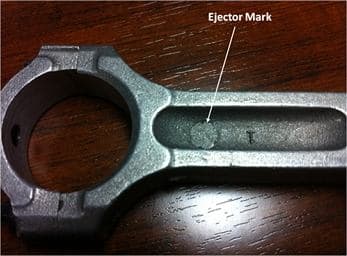
-----
How to identify sand-cast vs, die-cast aluminum motorcycle parts
Q. My thanks in advance for anyone's help!
I am preparing to anodize several parts on my 1995 Honda CB1000 motorcycle. They are cast aluminum, as such I must put them through a nitric acid/ammonium bifluoride bath. The dilution of this bath must be different for sand-cast vs die-cast aluminum.
My question is how can I tell if these parts are die-cast or sand-cast, so that I use the correct dilution? Are all aluminum motorcycle parts one type of casting or the other?
Raymond Coogan- Lake Havasu City, Arizona, USA
2004
A. An aluminum diecasting looks almost identical to a zinc diecasting, and somewhat like a plastic injection molded part, in that is is quite smooth and shiny because the molten aluminum is forced into a polished metal die set. A sand casting looks rough and grainy because the aluminum is poured into a hole dug into sand or similar material.
Because tolerances can be much tighter on a die casting, the wall thicknesses can be thinner; if the part looks 'spindly' it's probably a die casting. Carburetors are a very common example of die castings.

Ted Mooney, P.E.
Striving to live Aloha
finishing.com - Pine Beach, New Jersey
Ted is available for instant help
or longer-term assistance.
2004
A. Hi,
I have a 1979 BMW Motorcycle and the brake calipers are sand cast. I also am restoring a 1979 Honda CB900FZ and it's calipers are Zinc die cast. The Zinc castings corrode at the surface and quickly look awful ! whereas the BMW sand cast calipers look brand new ! and have a very pleasing lustre as there is no zinc in the material to corrode and spoil the finish.
Hope this helps you
Joe Geoghegan- Coventry, UK
2004
![]() Thank you all for your responses. As it turns out, you were all largely correct. The engine covers and most other parts are die cast, but my brake caliper bodies are sand cast. I'm just painting the calipers, so the die-cast solution (for once, a cheaper route!) is what I can use to prep the die cast for anodizing.
Thank you all for your responses. As it turns out, you were all largely correct. The engine covers and most other parts are die cast, but my brake caliper bodies are sand cast. I'm just painting the calipers, so the die-cast solution (for once, a cheaper route!) is what I can use to prep the die cast for anodizing.
- Lake Havasu City, Arizona, USA
2004
A. Die castings will have ejection pin marks at regular intervals/spacing on one or both sides of the longest feature/axis of the part. These will typically show up as shiny round circular indentations into the otherwise matte surface on any cast (non-machined) surfaces.

In addition, the parting line of a die cast part (if present) will be thinner and more regular than a sand cast part.
Mark Bitz- Spokane Valley, Washington, USA
September 8, 2015
Q, A, or Comment on THIS thread -or- Start a NEW Thread
